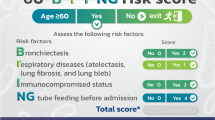Abstract
The severity and predicted outcome of postoperative Pseudomonas aeruginosa (P. aeruginosa) infections (PPAI) was evaluated using a severity scoring system based on a simplification and modification of the APACHE II system. A total of 86 patients in whom P. aeruginosa was isolated from various sources were examined. PPAI developed in 50 patients, resulting in an overall mortality rate of 24%. An increased severity score (SS) correlated with an increased risk of developing PPAI. Thus, PPAI developed in 33% of the patients with an SS of 0–1, in 66.7% of those with an SS of 2–3, and in 100% of those with an SS of 6 or higher. Moreover, the mortality rate of the patients with an initial score of 6 or higher was 50%. The mean (±SD) initial severity score was 5.4±2.9 for survivors and 2.9±2.6 for nonsurvivors (P<0.01). In the patients who subsequently died, the SS remained high throughout the clinical course despite therapy, whereas in the survivors the SS decreased progressively, reflecting a favorable clinical course. These results suggest that our severity scoring system was useful for predicting outcome and monitoring the response of PPAI to therapy.
Similar content being viewed by others
References
Richardson JD, Decamp MM, Garrison RN, Fry DE (1982) Pulmonary infection complication intra-abdominal sepsis. Clinical and experimental observations. Ann Surg 195:732–738
Kodama T, Yokoyama T, Takesue Y, Okita M, Nakamitsu A, Hiyama E, Imamura Y, Santo T, Murakami Y, Tsumura H, Hirata T, Miyamoto K, Tatsumoto N, Matsuura Y (1993) Evaluation of the severity and prediction of postoperative infection in patients with peritonitis and abdominal trauma, using a scoring system (in Japanese with English abstract). Nippon Shokaki Geka Gakkai Zasshi (J Jpn Gastroentrol Surg) 26:999–1006
Olson BO, Weinstein RA, Chamberlin W, Kabins SA (1984) Epidemiology of endemic Pseudomonas aeruginosa: Why infection control efforts have failed. J Infect Dis 150:808–816
Altemeier WA, Hummel RP, Hill EO, Lewis S (1973) Changing patterns in surgical infections. Ann Surg 178:436–445
Polk HC Jr, Borden S, Aldrete JA (1973) Prevention of Pseudomonas respiratory infection in a surgical intensive care unit. Ann Surg 177:607–615
Hilf M, Yu VL, Sharp J, Zuravleff JJ, Korvic JA, Muder RR (1989) Antibiotic therapy for Pseudomonas aeruginosa bacteremia: Outcome correlations in a prospective study of 200 patients. Am J Med 87:540–546
Knaus WA, Draper EA, Wagner DP, Zimmerman JE (1985) APACHE II: A severity of disease classification system. Crit Care Med 13:818–829
Elebute EA, Stoner HB (1983) The grading of sepsis. Br J Surg 70:29–30
Stevens LE (1983) Gauging the severity of surgical sepsis. Arch Surg 118:1190–1192
Skau T, Nystrom P, Carlsson C (1985) Severity of illness in intra-abdominal infection. A comparison of two indexes. Arch Surg 120:152–158
Britt MR, Shleupner CJ, Matsumiya S (1978) Severity of underlying disease as a predictor of nosocomial infection. JAMA 239:1047–1051
Shoemaker WC, Appel PA, Bland R (1983) Use of physiologic monitoring to predict outcome and to assist in clinical decisions in critically ill postoperative patients. Am J Surg 146:43–50
Giangiuliani G, Munson A, Gui D (1989) Validation of a severity of illness score (APACHE II) in a surgical intensive care unit. Intens Care Med 15:519–522
Pannier D, Christ NV (1991) Clinical outcome of seriously ill surgical patients with intra-abdominal infection depends on both physiologic (APACHE II) and immunologic (DTH score) alterations. Am Surg 213:130–136
Solomkin JO, Dellinger EP, Christ NV, Busuttil RAW (1990) Results of a multicenter trial comparing imipenem/cilastatin to tobramycin/clindamycin for intra-abdominal infections. Ann Surg 213:581–591
Evince M, Polka AV (1985) A score system for evaluating random control clinical trials of prophylaxis of abdominal surgical wound infection. Br J Surg 72:256–264
Knaus WA, Zimmerman JE, Wagner DP (1981) APACHE — acute physiology and chronic health evaluation: a physiologically based classification system. Crit Care Med 9:591–597
Ponting GA, Sim AJW, Dudley HAF (1987) Comparison of the local and systemic effects of sepsis in predicting survival. Br J Surg 74:750–752
Seneff M, Knaus WA (1990) Predicting patient outcome from intensive care: A guide to APACHE, MPM, SAPS, PRISM, and other prognostic scoring systems. J Intens Care Med 5:33–52
Goto S (1982) Mixed bacterial infection (in Japanese). Rinshoi 8:1104–1109
Miyamoto K, Yokoyama T, Ichikawa T, Kodama T, Takesue Y, Hiyama E, Matsuura Y (1992) Antibiotics management of perforated appendicitis in children (in Japanese with English abstract). Nippon Shoni Geka Gakkai Zasshi 28:999–1008
Romulo RLC, Palardy JE, Opal SE (1993) Efficacy of antimonoclonal antibody E5 alone or in combination with ciprofloxacin in neutropenic rats with Pseudomonas sepsis. J Infect Dis 167:126–130
Author information
Authors and Affiliations
Rights and permissions
About this article
Cite this article
Kodama, T., Yokoyama, T., Takesue, Y. et al. Severity and predicted outcome of postoperative Pseudomonas aeruginosa infections. Surg Today 25, 672–678 (1995). https://doi.org/10.1007/BF00311481
Received:
Accepted:
Issue Date:
DOI: https://doi.org/10.1007/BF00311481




